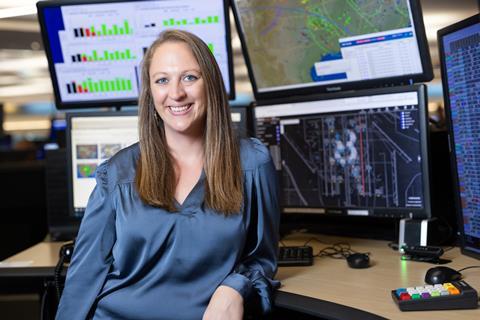When passengers board commercial airline flights, before turning right and walking down the aisle to their seats, they sometimes take a peek to the left, into the cockpit.
There, they usually see two pilots preparing the flightdeck for departure. Few passengers, however, are likely to realise that another highly-trained professional, sitting in an office far from the cockpit, shares responsibility for ensuring that their flight is conducted safely, economically and on time.
Rachael McMahon is one of those unseen crewmembers. She is a dispatcher at American Airlines, based at the carrier’s headquarters in Fort Worth, Texas.

“There’s one [assigned to] every single commercial airline flight,” she says. “We’re the additional crewmember, we’re behind the scenes. You don’t necessarily see us, but we’re in charge of all the pre-flight planning and paperwork that’s associated for that flight.”
McMahon is one of about 500 dispatchers at American, and has been doing the job for more than 15 years. About 80 of the carrier’s dispatchers are on duty during a typical daytime shift.
KEY ROLE
Dispatchers play a key role starting long before an aircraft departs and lasting until long after it lands. McMahon plans routes based on factors including weather and winds, aircraft performance, maintenance issues and weight. She also files flight plans for the pilots, who then sign off on the information and data.
“That’s just really the beginning of just one of the flights,” McMahon says. “We do this many, many, many dozens of times a day.”
When the aircraft takes off, the dispatcher keeps tabs on it throughout the flight.
“That’s the most important job,” she says. “You’re keeping an eye on everything. If the thunderstorm forecast wasn’t as you expected, you might have to adjust the flight plan en route with the captain, redo their fuel burn numbers [for] that new route, or even change altitude to avoid turbulence or icing.”
Dispatchers also help pilots respond to unexpected inflight problems – from maintenance issues to dealing with sick and injured passengers. They assist with diversions, ensuring flights land at airports with sufficiently long runways and with adequate support facilities.
“We are constantly in communication via the aircraft systems,” McMahon says. “The aircraft automatically sends us messages based on the location, fuel burn and other data. So that’s always data that’s being inputted to us that we constantly are monitoring.”
McMahon began her career at regional carrier Mesa Airlines in 2007. The US Federal Aviation Administration requires aircraft dispatchers receive at least 200h of specialised training and pass a written and practical exam.
“Once you get hired by an airline, you will take additional classes or training for your specific aircraft fleet,” she explains. That includes studying company manuals and performance manuals specific to aircraft types.
Years ago, McMahon had no idea such a job even existed, and it certainly wasn’t on her school or university career advisor’s radar.
“I never even knew that dispatch was a thing until I was actually in a dispatch office by happenstance,” she says. “I grew up always wanting to be in aviation, and in college I majored in aviation management and business administration.”
At Mesa, she was a customer service coordinator, but watched her dispatcher colleagues in awe. She learned that all the paperwork for every flight was not actually completed by the two pilots who flew the aircraft. “That was a new and interesting fact to me.” McMahon earned her dispatcher certificate in 2007, at the age of 24.
DOMESTIC FLIGHTS
She began – like all dispatchers – working domestic flights. As dispatchers gain experience and additional qualifications, they can advance to overseeing longer and more-complex operations, like international flights.
“We have a lot of people who are doing this for their second or third career,” she says. “We have dispatchers that are lawyers, they’re pilots, they’re all types of teachers, and [people] from within the airline or other airlines who worked their way up to dispatch. So it’s really a career that you can make at whatever time of your life.”
McMahon has worked her way up to become an IROPS lead – meaning she manages what airlines call “irregular operations”. In other words, she runs the show when good days turn terrible.
It is a new role, one that American recently created for its most experienced dispatchers. IROPS leads specifically help the airline recover from major disruptions like severe weather, which can throw its carefully choreographed and meticulously timed schedule into disarray. The goal is to create a response designed to affect the least number of aircraft, crew and customers possible.
“The most important thing about this line of work is being extra observant [and] organised – keeping everything moving in a safe fashion,” McMahon says. “You are that set of eyes on the ground, and you want to make sure that everything goes safely.”
For now, she can’t imagine doing anything else.
“I love my job. It is so interesting, it’s always different. I’ve learned so much, constantly, every day, about performance of airplanes and airports and climb performances and all the different and new aircraft that are coming in and their new capabilities.
“It’s fun and fascinating, and just so unique.”





















